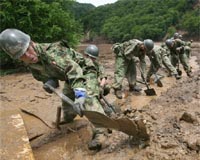| . |  |
. |
Sendai, Japan (AFP) March 14, 2011 Millions of Japanese were without food, water or power Monday and hundreds of thousands more were homeless as the disaster-struck economic superpower battled third-world conditions. Aid workers and search teams from across the world joined 100,000 Japanese soldiers in a massive relief push as the rattled country suffered a wave of major aftershocks and fresh tsunami scare, while temperatures plummeted. Store shelves and petrol stations emptied across the country as panic buying took hold following Friday's 8.9-magnitude quake and the resulting tsunami, with the state of a crippled nuclear power station putting nerves on edge. According to the United Nations, 2.6 million houses were without electricity and 3.2 million people were running out of gas supplies. Queues snaked across hard-hit Sendai city on the northeast coast as people waited patiently to stock up on essentials. Lines stretched from the few remaining phone boxes, with mobile signals patchy in the disaster zone. At one reopened supermarket, cheerful staff manned stalls in the car park carefully allocating food. Customers were allowed to buy up to two grapefruits, two oranges, chocolate, five bags of crisps, and up to two tins of tuna. Ravaged Ishinomaki, a town of about 165,000, is without power or communications and aid supplies have faltered due to transport damage. Half of the city is estimated to have been engulfed by the tsunami. "First of all, we have no drinking water," mayor Hiroshi Kameyama told public broadcaster NHK. "We also have neither food nor information." Asia-Pacific Red Cross spokesman Patrick Fuller, working in Ishinomaki, said it was a "desperate race against the clock to save those who may be trapped and wounded beneath colossal mounds of debris". "At the Red Cross hospital, no space is left unused. Exhausted Red Cross medics sleep side by side with the wounded," Fuller said on a Red Cross blog. "And still droves of injured people in need of medical help arrive. The wounded arrive on foot, by helicopter or carried by their fellow citizens." At least 1.4 million people in Japan are temporarily without running water and more than 500,000 people are taking shelter in evacuation centres, said the UN's Office for the Coordination of Humanitarian Affairs (OCHA). "The main humanitarian needs are food, drinking water, blankets, fuel and medical items which the government and private sector in Japan are urgently mobilising and sending to the affected area," OCHA said. Rolling blackouts began across the nation in a bid to save power, with the heavily nuclear-dependent nation rocked by explosions and meltdown fears at the Fukushima power plant as well as an oil refinery fire. The UN said power and gas supplies were critical, with the Japanese winter bringing sub-zero temperatures overnight and snow and rain forecast for coming days. "Rescue and relief operations are being hampered by continuous aftershocks, tsunami alerts, and fires," OCHA said. "Many areas along the northeast coast remain isolated and unreachable by emergency services." Soldiers were distributing heaters, emergency rations, blankets and water, and the military said some 10,000 people had been rescued. There had been landslides in dozens of regions and roads, bridges and railways had been washed away, while major highways to the ravaged northeast were closed to all but emergency traffic, according to the Japanese Red Cross. Boats, planes and helicopters were being used to ferry supplies and effect rescues, but teams were facing significant logistical problems. Medecins Sans Frontieres said water, food and blankets were the number one priorities on the ground and medical needs were growing across the country's 2,000 evacuation centres. "Clearly the level of devastation is huge, but the response by the Japanese authorities is also massive," MSF Japan director Eric Ouannes told AFP.
Share This Article With Planet Earth
Related Links Bringing Order To A World Of Disasters A world of storm and tempest When the Earth Quakes
 Japan to deploy 100,000 troops on quake aid
Japan to deploy 100,000 troops on quake aidTokyo (AFP) March 13, 2011 Japan will double to 100,000 the number of troops on rescue and relief missions after a massive earthquake and tsunami hit the northeast coast, the government said Sunday. Defence Minister Toshimi Kitazawa told a meeting of his ministry's emergency headquarters that he had received the order from Prime Minister Naoto Kan, a government official told AFP on condition of anonymity. Police ... read more |
|
| The content herein, unless otherwise known to be public domain, are Copyright 1995-2010 - SpaceDaily. AFP and UPI Wire Stories are copyright Agence France-Presse and United Press International. ESA Portal Reports are copyright European Space Agency. All NASA sourced material is public domain. Additional copyrights may apply in whole or part to other bona fide parties. Advertising does not imply endorsement,agreement or approval of any opinions, statements or information provided by SpaceDaily on any Web page published or hosted by SpaceDaily. Privacy Statement |